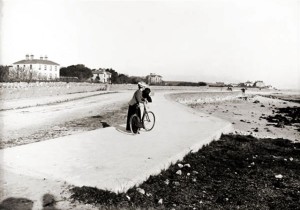Old Galway
THE MAY PROCESSION (09 05 13)

THE KNIGHTS OF MALTA IN GALWAY (02 05 13)

The first unit of the Order of Malta in Galway began in 1937 when Dr. Conor O’Malley was asked by the Marquis McSweeney, the then Chancellor of the Irish Association, to recruit members to form an Ambulance Corps aimed initially at Connacht only.In October of that year, Harry Warner asked the 5th year boys in the Bish if any of them were interested in joining a first aid class that Professor O’Malley was organising --- weekly lectures at the Central Hospital starting at 8pm.Only six places were available. All of the class were interested so six names were drawn out of a hat. They became known as ‘the schoolboys’.
Kevin Faller, Galway Poet (25 04 13)

Kevin Faller was born in the Crescent in 1920. His father was John Patrick Faller and his mother was Madeleine Quinn from Tuam. They both died within six months of each other when Kevin was very young, so he and his brother Liam were brought up by their grandfather Stephen Faller. Kevin’s Aunt Minnie, who was married to Nicholas O’Halloran, also helped to rear him.He grew up in Devon Park, and he used to play in Boland’s Wood and O’Hara’s Wood and in the general Devon Park/Taylors Hill area. He was educated in the Jes where he became very involved in rowing and coxed a number of successful crews.
Walking the Prom (18 04 13)

Towards the end of the 19th century, tourism interests in Galway used to advertise the Promenade as a place unrivalled in the country, where one could take the healthy invigorating salt air like nowhere else. In those times, it was just a narrow crooked roadway, very rough and untarred and the footpath seemed to extend from Palmer’s Rock to roughly opposite the entrance to Rockbarton, if one is to judge from how it finishes in the foreground of our photograph, which was taken c.1890. The road was known as the Lower Sea Road. The houses in the background are Belmore, owned by McDonoughs; Brinkwater owned by Maurice De Courcey Dodd; Maretimo owned by the O’Beirne family.
U. C. G. Rugby Club (11 04 13)

The rugby club in UCG was founded in1874, which makes it the oldest such club in Connacht. They played in the Bateman Cup competition many times and won their first Connacht Senior Cup in 1897. They have held this trophy aloft 34 times in all, more than any other club in the west, and they have won the senior league 16 times. They won the Dudley Cup for the first time in 1905. Many of their players have played for Irish Universities International teams, and ten have been capped for Ireland, several while playing for UCG. One of those, Ciaran Fitzgerald, captained the British and Irish Lions. The UCG colours are maroon and white.
Scoil Fhursa, 80 Years (04 04 13)

Scoil Fhursa opened on the 24th of April 1933, 80 years ago this month. It was named after the ‘laborious preacher and famous visionary’, St. Fursey who was born on Inchiquin on the Corrib towards the end of the 6th century. He performed many miracles both here and on the continent. The school building has an interesting and varied history. It was built by a group known as “The Irish Church Missions” who were set up in the UK with a view to converting Roman Catholics ‘from the errors of Popery’.They were told the west of Ireland would be a fruitful field for proselytising and so established a school in two houses in Merchant’s Road
MAYORALTY HOUSE AND LOWER CROSS STREET (28 03 13)

This photograph of Cross Street was taken in 1946. Early maps of the city show an open air altar at the end of the street. It was built by the Dominicans and used for various processions and Corpus Christi. The building facing us is Mayoralty House which was originally built in 1793 for a member of the Daly family. This family exclusively held the office of mayor from 1776 to 1816. It was probably built by James Daly who was mayor in 1804, 1810, 1814, 1818 & 1819. The Dalys owned the house until the late 1840’s. In Griffith’s Valuations in 1855, there is no mention of Mayoralty House, but a house fitting its description belongs to the Town Commissioners. These had replaced the Mayor and Corporation about 1935. It was later used as a police barracks.
THE MAGDALEN ASYLUM, GALWAY (21 03 13)

The Magdalen Asylum in Galway was founded in 1824 by a private person, Ms. Lynch, and was managed by a society known as The Association of Ladies of the Saint Magdalen Society. At the request of the founder, the Sisters of Mercy became responsible for the operation of the institution following her death in 1845. The laundry and living quarters were separate from the convent/mother house in Galway. The living quarters included three dormitories, a kitchen, dining room, infirmary, recreation room and a chapel. There was also a farm across the road.In the late 1800’s, there were at least 41 Magdalen Institutions in Ireland and they were known as Asylums, Refuges or Penitentiaries.
.png)